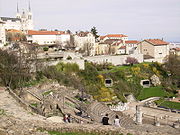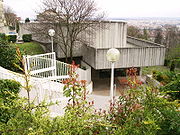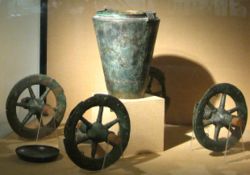
Gallo-Roman Museum of Lyon
Encyclopedia

Roman Gaul
Roman Gaul consisted of an area of provincial rule in the Roman Empire, in modern day France, Belgium, Luxembourg, and western Germany. Roman control of the area lasted for less than 500 years....
civilisation in Lyon
Lyon
Lyon , is a city in east-central France in the Rhône-Alpes region, situated between Paris and Marseille. Lyon is located at from Paris, from Marseille, from Geneva, from Turin, and from Barcelona. The residents of the city are called Lyonnais....
(Roman Lugdunum
Lugdunum
Colonia Copia Claudia Augusta Lugdunum was an important Roman city in Gaul. The city was founded in 43 BC by Lucius Munatius Plancus. It served as the capital of the Roman province Gallia Lugdunensis. To 300 years after its foundation Lugdunum was the most important city to the west part of Roman...
), previously located in the heart of the Roman city and now sited near the city's Roman theatre on the Fourvière
Fourvière
Fourvière is a district of Lyon, France located on a hill immediately west of the old part of the town, rising abruptly from the river Saône and then gently sloping down to the north-west. It is the site of the original Roman settlement of Lugdunum...
hill, half-buried into the hillside on the edge of the archaeological site. The new building was designed by Bernard Zehrfuss
Bernard Zehrfuss
Bernard Louis Zehrfuss was a French architect.-Life:From a family that had fled from the Alsace in 1870 after the Franco-Prussian War, Zehrfuss's father was killed in the First Battle of the Marne in 1914...
and opened in 1975. Internally, it is formed of a concrete spiral ramp descending and branching out into the display rooms. It is managed and operated by the Rhone
Rhône
Rhone can refer to:* Rhone, one of the major rivers of Europe, running through Switzerland and France* Rhône Glacier, the source of the Rhone River and one of the primary contributors to Lake Geneva in the far eastern end of the canton of Valais in Switzerland...
department jointly with the archaeological museum of Saint-Romain-en-Gal
Saint-Romain-en-Gal
Saint-Romain-en-Gal is a commune in the Rhône department in eastern France.-References:*...
. As well as displaying its own permanent collections of Roman, Celtic and pre-Roman material (inscriptions, statues, jewellery, everyday objects), a plan-relief
Plan-relief
A plan-relief is a scale model of a landscape and buildings produced for military usage, made to visualise building projects on fortifications or campaigns surrounding fortified locations.-History:...
of the ancient town and scale models of its major monuments such as the theatre
Antique theatre of Fourvière
The Roman theatre is a Roman ancient structure in Lyon, France. It was built next to the hill of Fourvière, which is located in the center of the Roman city.- Chronology :...
and the Odeon
Odeon of Lyon
The Odeon of Lyon is a small ancient Roman theatre near the summit of the Fourvière hill in Lyon, France. It forms a pair with the theatre, one of only two such pairs in Gaul .-History:...
, it also regularly hosts temporary exhibitions.


Notable objects

Circus Mosaic
Discovered in the AinayAinay
Ainay is an area within the Presqu'ile district in the 2nd arrondissement of Lyon, to the south of Place Bellecour and the north of Perrache. It is best known for its Romanesque church, the Basilica of Saint-Martin d'Ainay. A middle-class area in the city centre, its buildings mainly date to the...
district in 1806, this mosaic shows a circus during a chariot race, making it one of the few ancient representations of such a race (Lyon itself had a wooden circus).
Other
- the Gallic Coligny calendarColigny calendarThe Gaulish Coligny calendar was found in Coligny, Ain, France near Lyon in 1897, along with the head of a bronze statue of a youthful male figure. It is a lunisolar calendar...
- fragments of the decoration of the Altar of Rome and Augustus, from the federal sanctuary of the three Gauls
- the Lyon TabletLyon TabletThe Lyon Tablet is an ancient bronze tablet that bears the transcript of a speech given by the Roman emperor Claudius. The surviving bottom portion of the tablet was discovered in 1528 by a draper in his vineyard on Croix Rousse Hill , in Lyon, France...
, a speech by ClaudiusClaudiusClaudius , was Roman Emperor from 41 to 54. A member of the Julio-Claudian dynasty, he was the son of Drusus and Antonia Minor. He was born at Lugdunum in Gaul and was the first Roman Emperor to be born outside Italy... - large mosaics
- the Taurobolic AltarTaurobolic Altar (Lyon)The Taurobolic Altar is an inscribed ancient Roman altar found in 1704 in a vineyard belonging to a certain Bourgeat on the Fourvière hill in Lyon, France. It dates to 160 and refers to a taurobolium carried out in Lugdunum to Cybele for the restoration of the emperor Antoninus Pius's health. It is...
, dedicated in 160 to restore the health of Antoninus PiusAntoninus PiusAntoninus Pius , also known as Antoninus, was Roman Emperor from 138 to 161. He was a member of the Nerva-Antonine dynasty and the Aurelii. He did not possess the sobriquet "Pius" until after his accession to the throne... - many large DionysiacDionysusDionysus was the god of the grape harvest, winemaking and wine, of ritual madness and ecstasy in Greek mythology. His name in Linear B tablets shows he was worshipped from c. 1500—1100 BC by Mycenean Greeks: other traces of Dionysian-type cult have been found in ancient Minoan Crete...
sarcophagi, including the Sarcophagus of the Triumph of BacchusSarcophagus of the Triumph of Bacchus (Lyon)The Sarcophagus of the Triumph of Bacchus is a monumental ancient Roman stone sarcophagus of Carrara marble. The style and high quality of its reliefs and the choice of Bacchus triumphing over India as its subject suggest it came from a Roman workshop and possibly dates to the start of the 3rd... - the Lyon-Vaise HoardLyon-Vaise HoardThe Lyon-Vaise Hoard is a 3rd century ancient Roman hoard of precious objects, found in Lyon in 1992 and now on display in the Gallo-Roman Museum of Lyon. It includes dishes, jewellery, statuettes and coins. It was buried for fear of Germanic raids and the coins in it allow its burial to be dated...
of dishes, jewellery and silver statuettes buried during a 3rd century Germanic invasion

